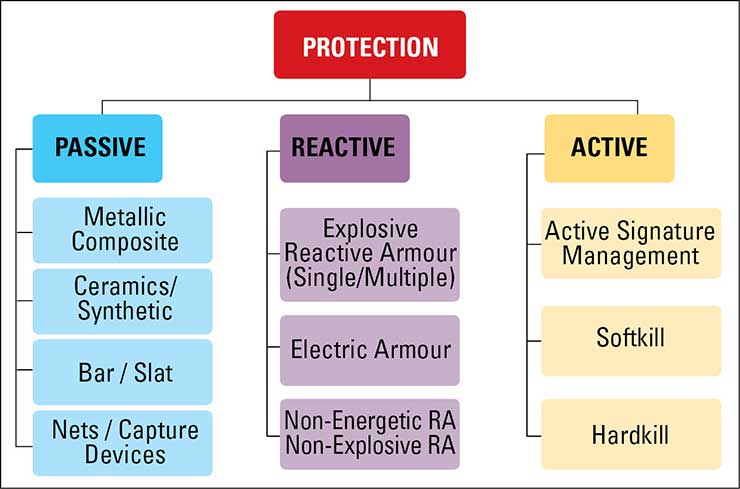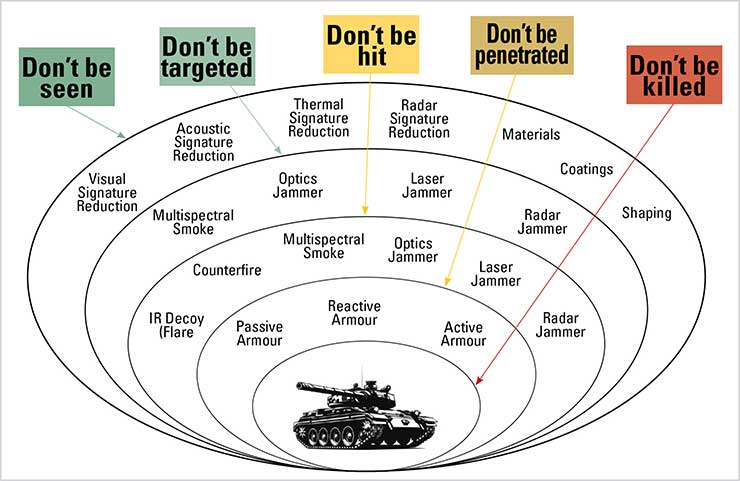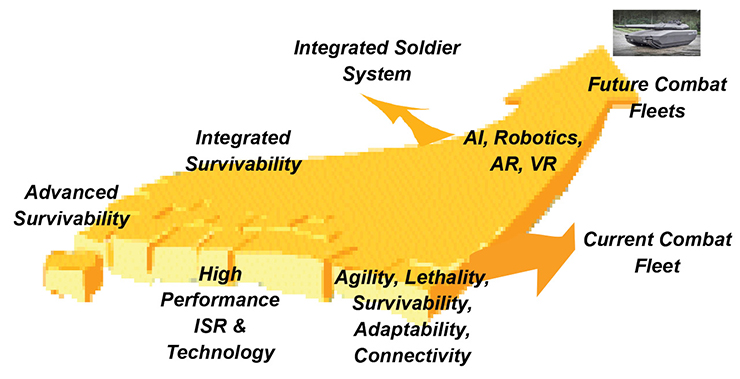Twenty-first century wars have seen a dramatic shift in their character. The reasons for conflict, the rules, the players, and the tools are constantly evolving. This makes warfare more complicated and contested. The multi-domain kinetic and non-kinetic threats along with the proliferation of unmanned systems pose a new challenge. The need is to make future forces more survivable and operational under such a canvas of multi-domain threats. It calls for thinking beyond protection to an all-encompassing concept of integrated balanced survivability.
As we view combat system design parameters, it is imperative to shift from the legacy Iron Triangle of Firepower, Protection and Mobility to a more relevant and holistic model of Lethality, Survivability, Manoeuvrability, Sustainability, Connectivity, Multi-role Adaptability and Affordability based on the commonality of base platform and technology convergence. Their balanced integration would lead to a more survivable and operationally viable combat system.
The Nagorno-Karabakh, Russia-Ukraine and Israel-Hamas conflict have certainly brought forth the larger canvas of survivability and the need to redefine its multiple yet integrated facets for its potency. The human elements of training, leadership, and tactics, adaptable to specific operational conditions and terrain add to the survivability canvas.

Current Approach to Protection
The current approach to protection revolves around passive, reactive and active armour solutions. These are certainly inadequate to meet today’s battlespace challenges.
The threats faced by military forces have evolved into a complex and multifaceted challenge in a multidomain battlespace. Adversaries now employ a diverse array of weapons and tactics, ranging from conventional warfare strategies to asymmetric approaches and even inciting public disorder. The kinetic and non-kinetic threats have fused seamlessly across all domains. Urban combat operations and long-range precision warfare have added to the vulnerability of combat platforms.
The threats faced by military forces have evolved into a complex and multifaceted challenge in a multidomain battlespace. Adversaries now employ a diverse array of weapons and tactics, ranging from conventional warfare strategies to asymmetric approaches and even inciting public disorder
Moreover, existing protection is primarily directional, leaving combat vehicles vulnerable to attacks from the bottom, rear, and top. Compounding these issues is the threat of multidirectional, multiple-domain simultaneous attacks on a single combat system, exploiting vulnerabilities of the conventional protection outlook. Furthermore, as adversaries move beyond manned platforms and traditional explosives-based attacks, there is a pressing need for survivability strategies to evolve accordingly to tackle non-kinetic threats. The proliferation of drones and unmanned combat vehicles has also added a new dimension to the top attack threats and survivability of combat vehicles. This necessitates an agile and adaptable survivability focus with technology-aided solutions to proactively counter future threats.

In the face of such challenges, military strategists will need to develop a new paradigm outlook to warfare from the legacy notion of protection to integrated survivability, to confront escalatory multidomain threats. This mandates an inclusive approach integrating disruptive technologies, innovative tactics, quality leadership, and advanced training to ensure adaptability and survivability in the future battlespace.
Survivability and Countermeasures
The concept of survivability and countermeasures (S&C) entails a comprehensive approach that integrates various elements, including vehicle silhouette profile, stealth technology, crew configuration, active protection systems (APS), and lightweight, configurable armour arrays. Further and most importantly, the non-tangible aspects of training, tactics, and leadership. Tanks are as good as the tankman and the tankman is as good as the operational doctrine, technology enablement and tactical skills. By employing a multi-layered kit, AFVs can enhance survivability while maintaining affordability and adaptability to evolving threats.
Military strategists will need to develop a new paradigm outlook to warfare from the legacy notion of protection to integrated surviva-bility, to confront escalatory multi-domain threats
The survivability of a vehicle is not the sum of the various protection systems available, but more the smart integration of all those components to use the quintessence of their characteristics. While the layered protection concept remains valid in terms of sequence, survivability brings in other elements that are not necessarily linked to the vehicle, such as networked situational awareness, leadership, tactics, and training impacting survivability.

Integrated Survivability Concept
Survivability of a combat system is generally assessed under three district aspects: susceptibility (detectable and being targeted), vulnerability (type of casualty if hit – mobility or destroyed), force protection (strategies or features aimed at safeguarding occupants), and recoverability. These are illustrated facing page:-
The concept of integrated survivability of combat systems is more holistic and comprehensive. It entails the right blend of technology, training, and tactics to ensure the survivability and resilience of combat platforms against myriad threats. From integrated networks, advanced sensors and adaptive armour solutions to futuristic autonomous mechanisms, advanced combat platforms are designed to detect, pre-empt, counter, and defeat a variety of threats both in the kinetic and non-kinetic domain. Thus, they are hard to see, hard to hit and hard to kill. Further by integrating proactive offensive capabilities with resilient defensive capabilities, integrated survivability enhances operational success in a contested and complex battlespace. Thus, integrated survivability is a holistic approach to warfare, where technology, training, leadership, tactics, adaptability, and resilience are integrated to attain combat superiority.

Balanced Survivability for Future
Balanced survivability entails seamless integration of ISR superiority, stealth technology, threat avoidance, hit avoidance, penetration evasion and redundancy for cumulative combat superiority. While the traditional concept of “survivability bulbs” provides a structured sequence of actions from the attacker’s perspective – from observation to destruction – the broader framework of intelligence, surveillance, and tactics add to enhance overall resilience and effectiveness. Thus, balanced survivability acknowledges the interconnectedness of diverse elements and emphasises the strategic fusion of factors such as situational awareness, strategic planning, and adaptability, all of which contribute significantly to a combat system’s ability to withstand and overcome threats in dynamic and challenging environments.
Integrated survivability is a holistic approach to warfare, where techno-logy, training, leadership, tactics, adaptability, and resilience are integrated to attain combat superiority
Future Survivability Roadmap
Future survivability focus must seamlessly integrate advanced technologies such as artificial intelligence, machine cognition, robotics, cyber resilience, and network-centric operations capabilities. It would also entail a healthy mix of manned and unmanned systems.
The networked approach to combine armed forces with interoperability between different platforms and units will enhance their resilience, agility, and adaptability contributing to mission accomplishment.will enhance their resilience, agility, and adaptability contributing to mission accomplishment. This integrated approach with all facets fused can ensure combat overmatch while mitigating risks and maximising success.

Summing up
Twenty-first century battlespace and the complexity of threats therein demand a transformative shift in the concept of combat survivability. The need is to transition from myopic system-oriented, passive protection to a holistic process-driven, proactive, pre-emptive, and integrated survivability capability. The future roadmap for survivability must fuse both offensive and defensive capabilities seamlessly integrated and interoperable across all combat systems. Integrated survivability also has an important human element of leadership, decision superiority based on information dominance, doctrines and adaptable tactics, combined arms, and manoeuvre warfare doctrines, besides leveraging advanced technologies. This approach to integrated and balanced survivability will result in force agility, resilience, and mission accomplishment in future battlespace.
–The author, a PVSM, AVSM, VSM has had an illustrious career spanning nearly four decades with the Indian Army. A distinguished Armoured Corps officer, he has served in various prestigious staff and command appointments including Commander Independent Armoured Brigade, ADG PP, GOC Armoured Division and GOC Strike 1. As DG Mechanised Forces, he was the architect to initiate process for reintroduction of Light Tank and Chairman on the study on C5ISR for the Indian Army. Subsequently he was Consultant MoD/OFB from 2018 to 2020. He is a reputed defence analyst, a motivational speaker and prolific writer on matters of military, defence technology and national security.The views expressed are of the writer and do not necessarily reflect the views of Raksha Anirveda
The author, a PVSM, AVSM, VSM has had an illustrious career spanning nearly four decades. A distinguished Armoured Corps officer, he has served in various prestigious staff and command appointments including Commander Independent Armoured Brigade, ADG PP, GOC Armoured Division and GOC Strike 1. The officer retired as DG Mechanised Forces in December 2017 during which he was the architect to initiate process for reintroduction of Light Tank and Chairman on the study on C5ISR for Indian Army. Subsequently he was Consultant MoD/OFB from 2018 to 2020. He is also a reputed defence analyst, a motivational speaker and prolific writer on matters of military, defence technology and national security. The views expressed are personal and do not necessarily carry the views of Raksha Anirveda






